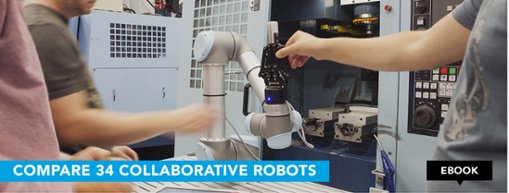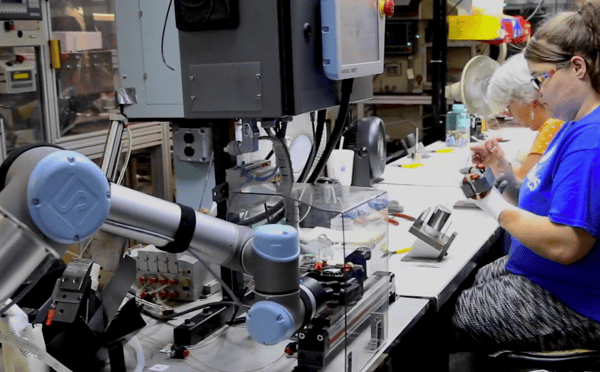How to Optimize a Flow Shop with Collaborative Robots

Posted on Apr 10, 2018 7:00 AM. 7 min read time
Want to improve process consistency in a machine shop? One thing that can help is flow shop sequencing, especially when it's done with collaborative robots.
If your workshop continuously produces the same product lines, you could probably benefit from "flow shop scheduling." This is a classic way of scheduling with long-established optimization methods.
Collaborative robots, or cobots for short, are a great fit for flow shops. At smaller flow shops, traditional automation may not be feasible due to the high amount of investment and floor space required. But cobots can help boost production in shops of all sizes.
In this article, we'll show you how you can apply flow shop scheduling to your process, and how collaborative robots can help improve flow.
What is a flow shop?
The term "flow shop" describes the sequence of machining operations in a production line. The product goes through each stage of the process in a consistent order, and all products go through each machine just once.
The key to running an optimized flow shop is creating a smooth flow between the different operations. In an ideal world, a flow shop would have no waiting times and no Work in Progress piling up between the stages. This may not always be the case in the real world, but fortunately, thanks to the long history of this type of production, there are some well-established methods of creating optimized flow sequences.
A brief history of the flow shop
One of the first notable flow shops was American car manufacturer Ford's Model T production line in 1913. Before this, Ford operated a "project shop" layout: the car stayed in one place throughout the production process, and workers transported materials to it.
This is the traditional process for small, artisan-made products, but it's hard to scale up for mass production. Operations are inefficient, and there are often problems getting materials in the right place at the right time.
By changing the factory into a flow shop, Ford reduced production time by 87%, and secured the Model T's place in the history of the industrial revolution.
Like all flow shops, Ford's production line prioritized consistent operations. This meant that workers were expected to work tirelessly, steadily, and without deviations in quality – you could even say they had to work "like robots."
How robots fit into flow shops
Robots are ideal for carrying out consistent operations because of their high repeatability. As a result, they've become an integral part of flow shop design. Today they're widely used in the automotive, aerospace and consumer goods industries, among others.
Predictability is the key to productivity in a flow shop. If you know how long an operation will take, you can schedule it effectively. Unknown or variable operation times lead to delays and work buildups. Robots can help smooth out the flow.
How flow shop scheduling improves productivity
First, let's look at how basic flow shop scheduling works.
In this example, four jobs have to be completed. Each job involves two machines operating one after the other:
|
Job |
Operation 1 (hours) |
Operation 2 (hours) |
|
A |
1 |
3 |
|
B |
5 |
2 |
|
C |
2 |
6 |
|
D |
7 |
4 |
The simplest way to schedule the jobs is to put all of them through one-by-one, starting with Job A and ending at Job D. This results in a cycle time of 19 hours, which ends when the final job leaves Machine 2:
|
Job |
Machine 1 In |
Machine 1 Out |
Machine 2 In |
Machine 2 Out |
|
A |
0 |
1 |
1 |
4 |
|
B |
1 |
6 |
6 |
8 |
|
C |
6 |
8 |
8 |
14 |
|
D |
8 |
15 |
15 |
19 |
How flow shops can optimize a process
Basic flow shop scheduling involves ordering the jobs in such a way as to minimize the overall cycle time. This is done using a method called Johnson's rule, which works like this (for the two-machine example):
- Schedule the job with the smallest operation time first. In our example, we schedule Job A first.
- Take the next shortest operation time and do the same, working towards the centre of the job queue. In our example, we schedule Job B last.
- Repeat steps 1 and 2 until you've scheduled all the jobs.
This process gives us the following sequence:
A -> C -> D -> B.
As you can see in the chart below, it results in a cycle time of 17 hours:
|
Job |
Machine 1 In |
Machine 1 Out |
Machine 2 In |
Machine 2 Out |
|
A |
0 |
1 |
1 |
4 |
|
C |
1 |
3 |
3 |
9 |
|
D |
3 |
10 |
10 |
14 |
|
B |
10 |
15 |
15 |
17 |
So we achieved a 10% improvement just by reordering the jobs!
Of course, depending on how many machines you have, this type of scheduling can get very complex. That's why you'll probably want to use production scheduling software instead of the manual method shown here.
How collaborative robots help in flow shops
Collaborative robots can improve the productivity of small flow shops through two important contributions:
- Consistency—Cobots help make the cycle times more consistent, which makes it easier to optimize process schedules.
- Speed—Although cobots are slower than industrial robots, they're often able to move faster than humans would in a consistent manner.
Here are some things you could have your cobots do to improve the flow of your process:
- Consistently reduce the cycle time of one operation to improve the overall cycle time.
- Perform simple operations, so human operators are free to work on operations that are restricting flow.
- Prepare products for the next stage in a way that improves the operation time of that stage.
- Transport products between different CNC machines to achieve more consistent operation times.
One final suggestion: once you've improved the cycle time of an individual operation, calculate the flow shop schedule using the new values and see how much of an improvement you can get!
Have you thought of any ways to use flow shop scheduling or collaborative robots in your process? Which factors have the biggest effect on productivity? Tell us in the comments below, or join the discussion on LinkedIn, Twitter, Facebook or the DoF professional robotics community.








Leave a comment